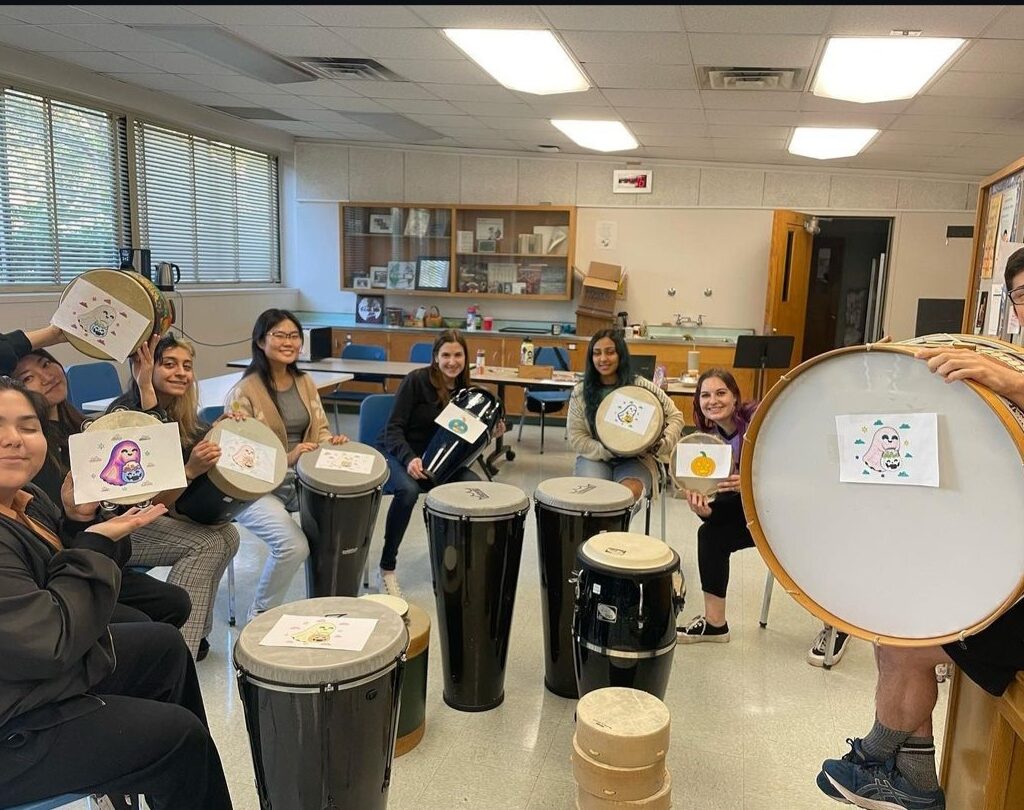Music possesses power. It brings people together, stirs emotions and has ability to heal in the form of music therapy.
For the past 40 years, the Music Therapy Program at California State University, Northridge has been training students to use music as a transformative tool to help people recover from trauma.
“Music therapy is using music as the vehicle in interventions to target non-musical skills and behaviors in individuals of all ages, to promote functional well-being,” said Hilary Yip, Director of CSUN’s Music Therapy Program, which was recently ranked ninth in the nation by Bestvalueschools.org.
That reputation was hard earned, said professor emeritus Ron Borczon, who started the program in 1984 in the Department of Music of what is now the Mike Curb College of Arts, Media, and Communication. It began to gain national recognition in 1994, when Borczon developed a protocol to work with children dealing with trauma following the 1994 Northridge Earthquake. He also developed group drumming experiences and chants to help people express grief after the terrorist attacks of Sept. 11, 2001.
“I think of it as having their own nonverbal voice because now their voices are through the instruments and the music,” Borczon said. He ventured that the program has graduated about 300 students, who work at music therapy practices or create private practices of their own.
To effectively use music as a therapeutic tool, CSUN students are expected to become proficient in guitar, piano, voice and musical repertoire. They are also required to take music, psychology and science courses and complete 1,200 hours of clinical training.
Part of this training includes a six-month, full-time internship at a facility anywhere in the country. Borczon said students have trained at clinics as far away as Boston, Miami and New York.
“By having our students be in so many different places, and people getting to see what we have, I think that might have been helpful in showing what kind of student we put out,” he said.
Yip said students are trained to work with a variety of clients, ranging from children to older adults with a diagnosis or disability. Clients may have autism, neurodivergence, depression, anxiety or other disorders. Students may also work with hospitalized patients experiencing pain or in hospice. Some students have even worked with people institutionalized by the justice system, using music to soothe anxiety.
“While music therapy does involve listening to music, that only scratches the surface of how it can be utilized,” she said. “There are therapy paths that involve listening to and playing music to assist with motor rehabilitation.”
Yip says composing music and lyrics can open the door to processing emotions, such as grief. Improvising music can even help with teaching individuals how to create social connections.
Borczon said the field is constantly evolving and adapting, noting that when the COVID-19 pandemic hit, practitioners in the CSUN Music Therapy Wellness Clinic quickly switched to Zoom and created a telehealth model to work with clients.
“You give us a goal to achieve, we’ll develop a music program to achieve it,” Borczon said.
Borczon said he is encouraged by the recognition music therapy has received by other segments of the scientific community.
“There’s a lot of collaboration between neuroscientists and music therapists to see how the brain is affected by music,” Borczon said. “They’re learning so much, like how when you’re playing music your whole brain just lights up as opposed to just listening to it.”
Yip said she is optimistic about the increase of diversity and representation in the field.
“I’ve been a music therapist for 13 years, and I’m seeing an increase of diversity and representation in music therapists, which is fantastic,” she said. “A lot of the clients we serve are also diverse. It’s wonderful to see more interest from students who want to study music therapy with a wide variety of cultures and influences.”
Like this:
Like Loading...
Related





 Tweet This
Tweet This Facebook
Facebook Digg This
Digg This Bookmark
Bookmark Stumble
Stumble RSS
RSS
































REAL NAMES ONLY: All posters must use their real individual or business name. This applies equally to Twitter account holders who use a nickname.
0 Comments
You can be the first one to leave a comment.